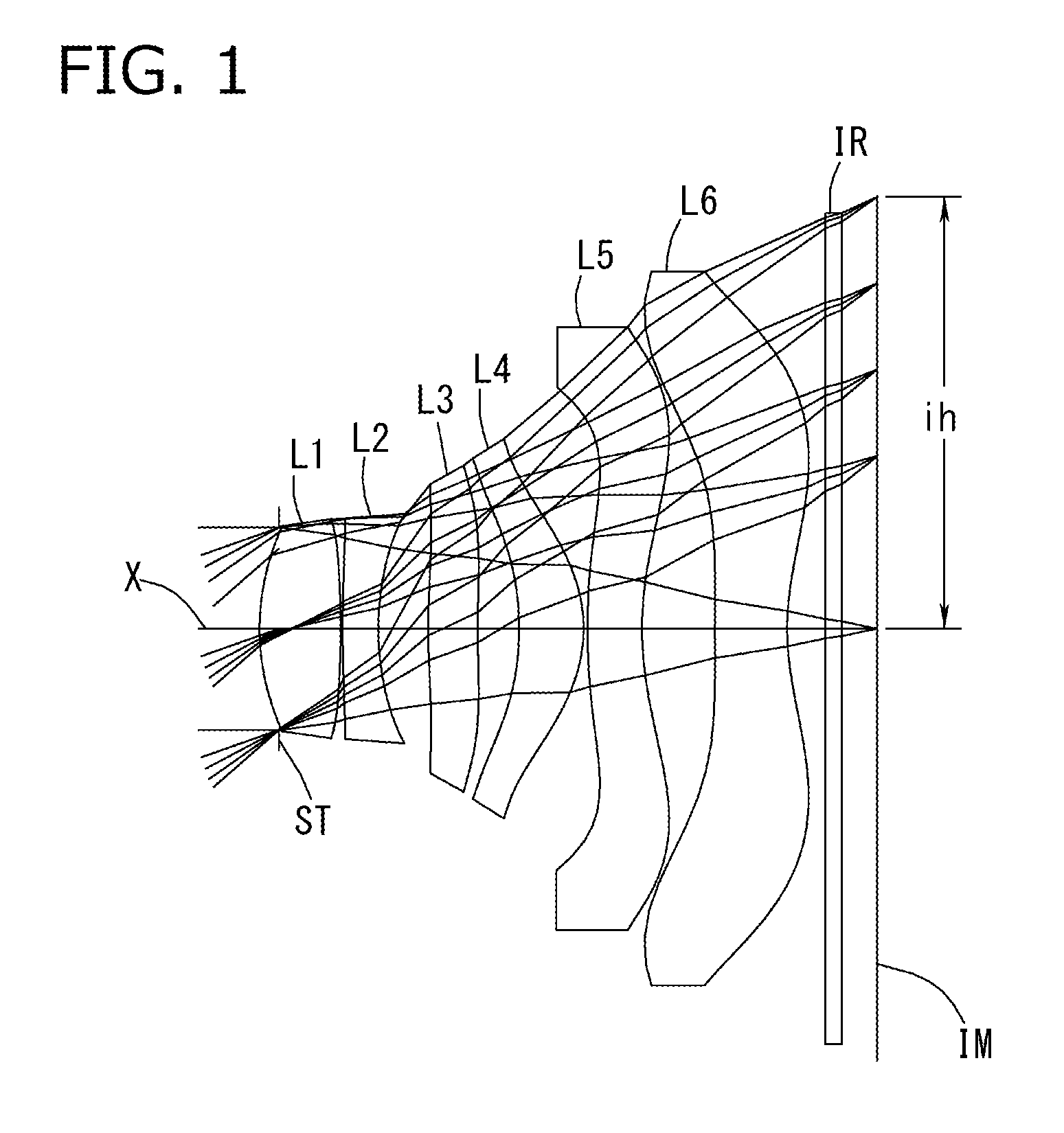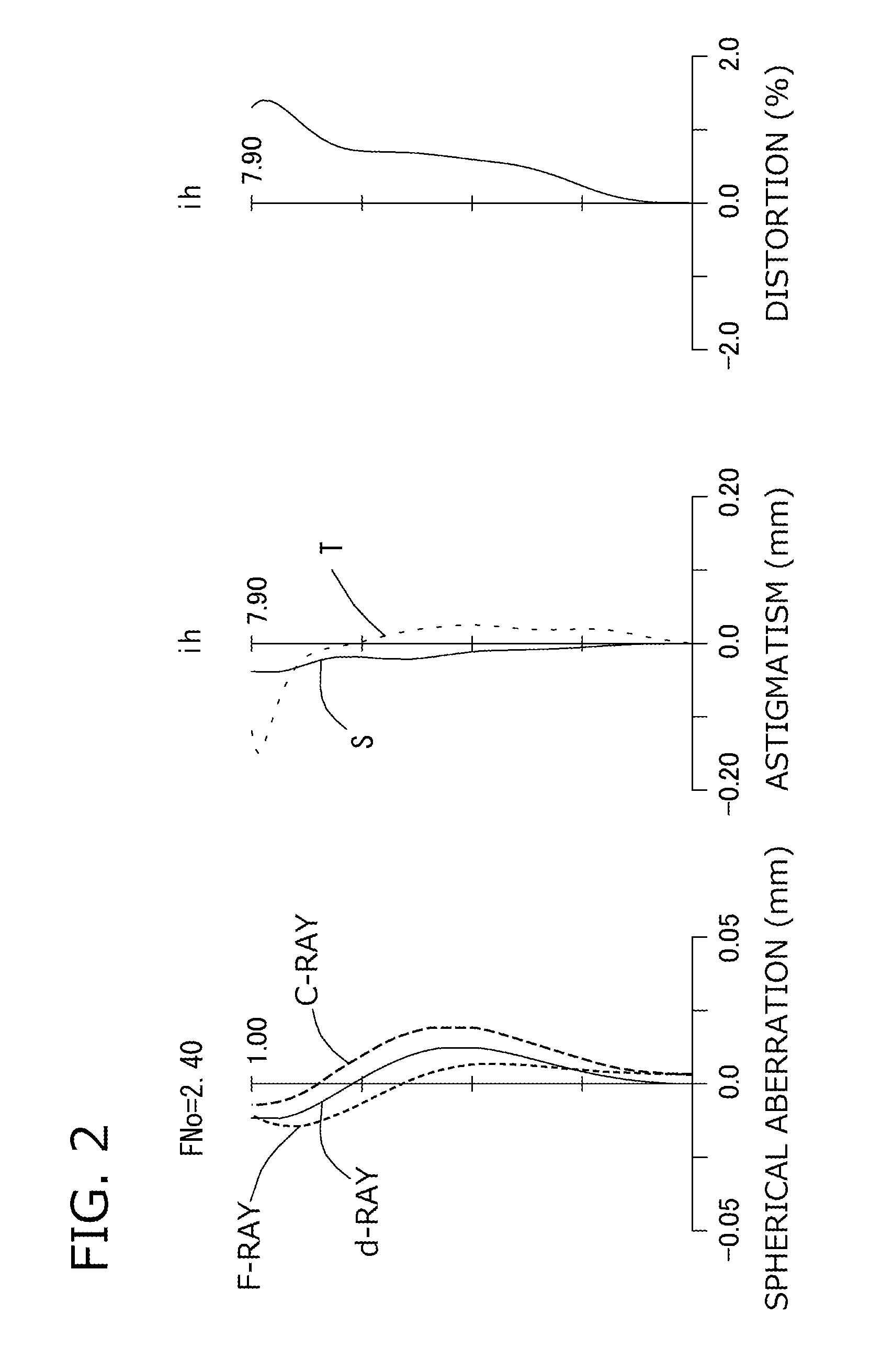Imaging lens
a technology of image sensor and lens, applied in the field of image lens, can solve the problems of inability to meet the demand satisfactorily, inability to deliver satisfactory optical performance, and difficulty in delivering the same level of high optical performance as in a small image sensor, so as to achieve enhanced telephoto ability and prevent the increase of total track length
- Summary
- Abstract
- Description
- Claims
- Application Information
AI Technical Summary
Benefits of technology
Problems solved by technology
Method used
Image
Examples
example 1
[0118]The basic lens data of Example 1 is shown below in Table 1.
[0119]
TABLE 1Example 1in mmf = 8.881Fno = 2.40ω(°) = 41.3ih = 7.902Surface DataCurvatureSurfaceRefractiveAbbeSurface No. iRadius rDistance dIndex NdNumber vd(Object Surface)InfinityInfinity 1 (Stop)Infinity−0.355 2*4.2751.4841.543855.57 3*−15.0550.040 4*46.7400.6501.614225.58 5*5.1590.913 6*13.2630.9091.534656.16 7*24.8710.751 8*−5.6001.1821.534656.16 9*−2.6700.07010*12.4431.0001.614225.5811*6.1231.33012*81.9181.3251.534656.1613*4.7250.60014Infinity0.3001.567037.8015Infinity0.746Image PlaneInfinityConstituent Lens DataLensStart SurfaceFocal Length126.29324−9.4983651.739488.369510−20.885612−9.435Composite Focal Lengthf123455.88f56−6.17Aspheric Surface Data2nd Surface3rd Surface4th Surface5th Surface6th Surface7th Surfacek0.000E+000.000E+000.000E+000.000E+000.000E+000.000E+00A4−7.869E−04 7.232E−034.714E−03−2.930E−03 −8.477E−03 −7.907E−03 A6−2.818E−04 −2.373E−03 −2.894E−04 2.261E−036.556E−041.565E−04A84.033E−05−1.9...
example 2
[0123]The basic lens data of Example 2 is shown below in Table 2.
[0124]
TABLE 2Example 2in mmf = 6.764Fno = 2.40ω(°) = 41.2ih = 5.992Surface DataCurvatureSurfaceRefractiveAbbeSurface No. iRadius rDistance dIndex NdNumber vd(Object Surface)InfinityInfinity 1 (Stop)Infinity−0.185 2*4.0531.0661.543855.57 3*−8.8160.101 4*35.0890.5001.614225.58 5*4.1550.648 6*8.5440.7101.534656.16 7*29.0840.609 8*−4.0381.3051.534656.16 9*−2.0160.05310*11.9030.7901.614225.5811*5.0030.60612*6.3661.0971.534656.1613*2.5250.60014Infinity0.3001.567037.8015Infinity0.850Image PlaneInfinityConstituent Lens DataLensStart SurfaceFocal Length125.25924−7.7203622.360486.148510−14.692612−8.694Composite Focal Lengthf123417.09f56−5.12Aspheric Surface Data2nd Surface3rd Surface4th Surface5th Surface6th Surface7th Surfacek0.000E+000.000E+000.000E+000.000E+000.000E+000.000E+00A4−2.806E−03 1.014E−023.547E−03−1.407E−02 −1.733E−02 −8.408E−03 A6−1.408E−03 −6.129E−03 6.567E−047.185E−037.447E−04−5.976E−04 A81.483E−04−8.568E...
example 3
[0128]The basic lens data of Example 3 is shown below in Table 3.
[0129]
TABLE 3Example 3in mmf = 6.765Fno = 2.40ω(°) = 41.2ih = 5.992Surface DataCurvatureSurfaceRefractiveAbbeSurface No. iRadius rDistance dIndex NdNumber vd(Object Surface)InfinityInfinity 1 (Stop)Infinity−0.185 2*4.0451.1071.543855.57 3*−9.4090.092 4*27.8490.5001.614225.58 5*4.1460.664 6*9.2630.7101.534656.16 7*37.9160.583 8*−4.0001.3201.534656.16 9*−2.0160.05310*12.0180.7901.614225.5811*5.1290.62612*5.9031.0451.534656.1613*2.4400.70014Infinity0.3001.564051.3015Infinity0.778Image PlaneInfinityConstituent Lens DataLensStart SurfaceFocal Length125.35724−7.9943622.730486.172510−15.234612−8.692Composite Focal Lengthf123416.97f56−5.20Aspheric Surface Data2nd Surface3rd Surface4th Surface5th Surface6th Surface7th Surfacek0.000E+000.000E+000.000E+000.000E+000.000E+000.000E+00A4−2.321E−03 1.017E−022.905E−03−1.319E−02 −1.643E−02 −8.716E−03 A6−1.169E−03 −5.693E−03 7.463E−046.718E−037.583E−04−4.328E−04 A81.335E−04−9.045E...
PUM
 Login to View More
Login to View More Abstract
Description
Claims
Application Information
 Login to View More
Login to View More - R&D
- Intellectual Property
- Life Sciences
- Materials
- Tech Scout
- Unparalleled Data Quality
- Higher Quality Content
- 60% Fewer Hallucinations
Browse by: Latest US Patents, China's latest patents, Technical Efficacy Thesaurus, Application Domain, Technology Topic, Popular Technical Reports.
© 2025 PatSnap. All rights reserved.Legal|Privacy policy|Modern Slavery Act Transparency Statement|Sitemap|About US| Contact US: help@patsnap.com



